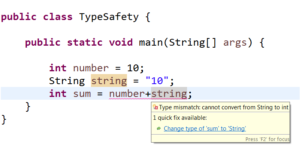Definition
Type safety is prevention of typed errors in a programming language.
A type error occurs when someone attempts to perform an operation on a value that doesn’t support that operation.
In simple words, type safety makes sure that an operation o which is meant to be performed on a data type x cannot be performed on data type y which does not support operation o.
That is, the language will not allow you to to execute o(y).
Example:
Let’s consider JavaScript which is not type safe:
<!DOCTYPE html> <html> <body> <script> var number = 10; // numeric value var string = "10"; // string value var sum = number + string; // numeric + string document.write(sum); </script> </body> </html>
Output:
1010
The output is the concatenation of number and string.
Important point to note here is that JavaScript is allowing you to perform an arithmetic operation between an int and string.
As JavaScript is not type safe, you can add a numeric and string without restriction. This can lead to typed errors in type safe programming languages.
Let’s consider java which is type safe:

You can clearly observe that in java the compiler validates the types while compiling and throwing a compile time exception:
Type mismatch: cannot convert from String to int
As java is type safe, you cannot perform an arithmetic operation between an int and string.
Take away
Type-safe code won’t allow any invalid operation on an object and the operation’s validity depends on the type of the object.
